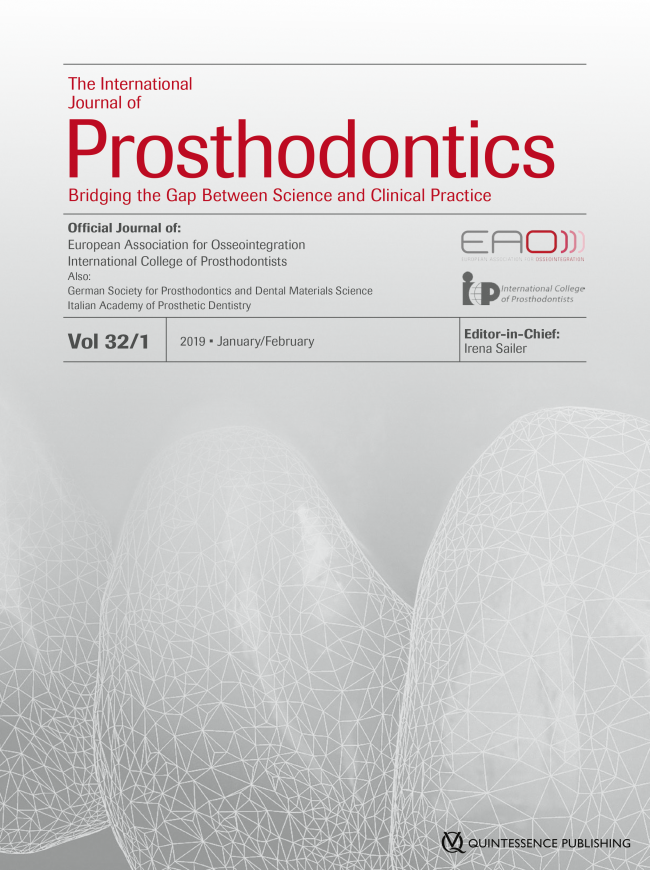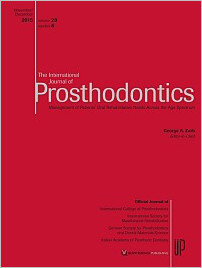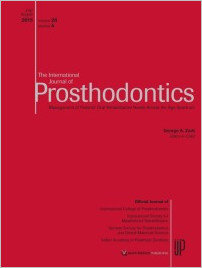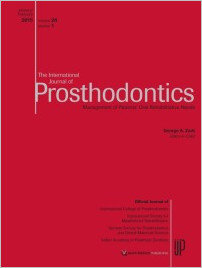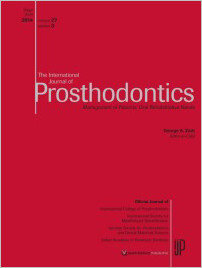PubMed-ID: 27164727Seiten: 111-112, Sprache: EnglischCurtis, DonSeiten: 114, Sprache: EnglischThe following were selected as the two best scientific posters presented at the 34th International Congress of the Italian Academy of Prosthetic Dentistry held on November 19-21, 2015.
DOI: 10.11607/ijp.4402, PubMed-ID: 26929947Seiten: 115-125, Sprache: EnglischZhang, Lei / Ding, Qian / Liu, Cunrui / Sun, Yannan / Xie, Qiufei / Zhou, YongshengPurpose: This systematic review attempted to determine the survival rate of implants placed in bone flaps in jaw rehabilitation and the functional gains and the most common complications related to these implants.
Materials and Methods: An electronic search was undertaken of PubMed, EMBASE, and CNKI records from 1990 through July 2014. Two independent examiners read the titles and abstracts of the results to identify studies that met the inclusion criteria. Subsequently, the reference lists of the selected publications were hand searched. Descriptive statistics were used to report all data related to the survival rate of implants placed in bone flaps in jaw rehabilitation, the functional gains, and complications.
Results: A total of 20 studies were included for systematic review without repetition. The mean follow-up time after implant placement ranged from 1.75 to 9.5 years. Within the limitations of available studies, the survival rate of implants placed in bone flaps in jaw rehabilitation ranged from 82.4% to 100%. Of the 20 included studies, 15 reported a survival rate higher than 90%. The cumulative survival rate was 93.2%, with the longest follow-up time being 12.9 years. The most common complications related to these implants were peri-implant bone resorption or peri-implant inflammation, and peri-implant soft tissue proliferation. The main factors associated with the survival rate of implants in bone flaps were reported as time of implant placement and radiotherapy. Despite some persistent soft tissue problems and implant loss, most patients reached a satisfactory functional and esthetic outcome, as evaluated by clinical examination and subjectively by the patients at interview. Implantsupported dental prosthetic rehabilitation in reconstructed jaws improved the quality of life in terms of speech, nutrition, oral competence, and facial appearance.
Conclusion: Placement of implants in bone flaps in jaw rehabilitation was demonstrated to be a reliable technique with a high survival rate. Multicentered randomized controlled clinical trials and longer clinical studies should be undertaken in this area.
DOI: 10.11607/ijp.4277, PubMed-ID: 26929948Seiten: 126-131, Sprache: EnglischBalshi, Thomas J. / Wolfinger, Glenn J. / Alfano, Stephen G. / Balshi, Stephen F.Purpose: Acrylic resin teeth on fixed implant prostheses are subject to time-dependent wear. The purpose of this retrospective analysis is to evaluate and describe the management of such wear in the context of selected variables-patient gender and age, dental arch location, and opposing dentition. The clinical and dental laboratory process to replace the worn teeth is defined as a retread.
Materials and Methods: A retrospective database review from a single private prosthodontic practice was carried out on all patients who had undergone a retread procedure. The patient pool included 205 arches in 194 patients (70 in men, 135 in women) with a mean age of 57.4 years (range: 19.9 to 80.5 years). The retread procedure is described.
Results: The mean time between final prosthesis delivery and retread was 7.8 years (range: 1.1 to 22.9 years). Statistical analysis was significant according to dental arch and opposing dentition. A statistical difference was also noted in patients undergoing multiple retread procedures, with a reduction in time between the subsequent procedures.
Conclusion: Acrylic resin components of implantsupported hybrid prostheses wear over time and are influenced by a combination of the nature of the opposing dentition and patient habits. The dental laboratory process to retread the implantsupported framework is important for long-term patient care and maintenance of an appropriate vertical dimension of occlusion.
DOI: 10.11607/ijp.4473, PubMed-ID: 26929949Seiten: 132-134, Sprache: Englischde Andrade, Juliana Gracinda Pena / Valerio, Claudia Scigliano / Monteiro, Marco Antônio de Oliveira / Machado, Vinícius de Carvalho / Manzi, Flávio RicardoThis study compared the accuracy of linear measurements of the alveolar ridge in images obtained using 64-detector-multislice computed tomography (CT) and cone beam CT (CBCT). Eight sites were selected corresponding to the regions of molars, premolars, canines, and incisors in six dry human jaws. After the completion of multislice CT and CBCT, the jaws were sectioned into specific regions. Results showed there was no statistically significant difference between the measurements obtained from the CT images and those obtained from dry jaws (actual measurements) for all the evaluated sites (molars, premolars, and anterior teeth). There was also no statistically significant difference between the measurements obtained by the two CT methods.
DOI: 10.11607/ijp.4353, PubMed-ID: 26929950Seiten: 135-138, Sprache: EnglischLayton, Danielle M.Clinicians and readers rely on accurate identification of articles to answer clinical questions and explore hypotheses. Commonly, these questions relate to the outcome and survival of dental treatments. Errors in indexing and inconsistencies in descriptions of these studies have meant that such articles are difficult to locate. To help address this problem, sensitive, precise and optimized electronic search strategies have been developed, and this article aims to explain how these new strategies can be used. These electronic search strategies have been shown to improve the identification of dental survival analyses.
DOI: 10.11607/ijp.4312, PubMed-ID: 26929951Seiten: 139-141, Sprache: EnglischVieira, Antonio Helio / Silva, Donizete Castro e / Nogueira, Túlio Eduardo / Leles, Cláudio RodriguesThe Theory of Planned Behavior (TPB) was used to assess subjects' intentions and behavior to predict willingness to undergo prosthodontic care. A questionnaire was administered to 225 adults with history of teeth loss who currently were not under prosthodontic treatment. The questionnaire comprised TPB components (attitude toward behaviour [ATB], subjective norm [SN], and perceived behavioral control [PBC]) containing items with potential influence on the intentions and behavior of individuals toward prosthodontic care. Clinical and socioeconomic data were also assessed. A path regression model was constructed explaining two dependent variables simultaneously: one explained the influence of PBC on intention (R2 = 0.04) and another explained the influence of dental arch, position of lost teeth, socioeconomic status, and PBC on behavior (R2 = 0.31). It was concluded that PBC was a relevant TPB component that encompasses perception of costs, opportunity cost, perceived need, and access to dental care. Clinical and socioeconomic factors were also major determinants of behavior toward prosthodontic treatment.
DOI: 10.11607/ijp.4458, PubMed-ID: 26929952Seiten: 142-146, Sprache: EnglischScherg, Stefan / Karl, MatthiasPurpose: Procera Implant Bridges (PIBs) do not engage supporting implant shoulders and are fixed using comparably long retention screws. The aim of this in vitro clinical study was to determine the detorque values in PIBs and conventionally fabricated fixed dental prostheses (FDPs).
Materials and Methods: Two groups of screw-retained implant-supported threeunit FDPs (n = 10) were fabricated by means of conventional casting or computer-aided design/computer-assisted manufacture to fit an in vitro situation with two implants. Following fixation, the restorations were subjected to masticatory simulation (100,000 cycles, 100 N) and subsequent detorquing of the retention screws. In the clinical part, a total of 10 patients received PIB restorations in the premolar/molar region that were detorqued after 2, 4, and 6 months. One-sample t tests adjusted for multiple testing by the Bonferroni-Holm method were applied for statistical analysis based on percentage detorque values (α = .05).
Results: 60% of the initial torque values were maintained in screws directly retaining restorations, while the abutment screws used in the conventional restorations showed detorque levels in the range of 80%. No significant difference in detorque levels between screws retaining PIBs and conventional FDPs could be detected (P = .5186). The abutment screws showed significantly greater detorque values compared with screws directly retaining restorations (P = .0002; P = .0000). In vivo, a significant increase in detorque values ranging from 21.64 Ncm after 2 months to 27.81 Ncm after 6 months was recorded.
Conclusion: Prosthetic screws retaining implantsupported FDPs show torque loss during the initial period of service. Retightening reduces the amount of future torque loss.
DOI: 10.11607/ijp.4444, PubMed-ID: 26929953Seiten: 147-153, Sprache: EnglischKing, Paul / Maiorana, Carlo / Luthardt, Ralph G. / Sondell, Katarina / Øland, Jesper / Galindo-Moreno, Pablo / Nilsson, PeterPurpose: For patients with narrow, single-tooth edentulous ridges as a result of permanent tooth agenesis (hypodontia) in the maxillary lateral and mandibular incisor regions, dental implant treatment may present a reliable and predictable restorative treatment solution. The aim of the present study was to evaluate the clinical reliability and outcome of small-diameter dental implants placed in a one-stage procedure with early loading replacing maxillary lateral or mandibular incisor teeth.
Materials and Methods: Patients with hypodontia in the maxillary lateral incisor or mandibular incisor region analyzed in this report were selected from a larger prospective multicenter study. Small-diameter dental implants (AstraTech OsseoSpeed TX 3.0 S, Dentsply) of different lengths were placed using a one-stage surgical protocol with a 6- to 10-week healing period before loading. Probing pocket depth, bleeding on probing, and gingival zenith score were assessed after 6, 12, 24, and 36 months. Radiographic examination was assessed at 6, 12, and 36 months.
Results: In total, 38 patients were included in this analysis and 62 small-diameter implants were placed. The mean distance between adjacent teeth was 6.30 mm (SD: 1.36). All patients received a titanium transmucosal abutment and cement-retained ceramic crown after 6 to 10 weeks of healing. Two implants were lost during the healing period before loading, providing a total implant survival rate of 96.8%. No implant fractures were reported. Mean marginal bone level change from surgery to follow-up visits at 6, 12, and 36 months were 0.39 mm, 0.22 mm, and 0.23 mm, respectively. The condition of soft tissue was stable at all follow-up visits with clinically insignificant changes in probing depth, bleeding on probing, and gingival zenith score.
Conclusion: This study evaluated the behavior over 36 months of AstraTech Osseospeed TX 3.0 S dental implants placed into narrow one-tooth defect edentulous ridges as a result of hypodontia. The data collected highlighted the stability of the marginal bone level and soft tissues around the dental implants in conjunction with durable mechanical function. Small-diameter implants can be considered a valid solution in the restorative treatment of hypodontia in the maxillary lateral and mandibular incisor regions.
DOI: 10.11607/ijp.4398, PubMed-ID: 26929954Seiten: 154-156, Sprache: EnglischSkupien, Jovito Adiel / Kreulen, Cees / Opdam, Niek / Bronkhorst, Ewald / Pereira-Cenci, Tatiana / Huysmans, Marie-CharlottePurpose: The aim of this study was to examine the effect of remaining buccal cavity wall, remaining cervical tissue, and post on the fracture strength of endodontically treated restored premolars.
Materials and Methods: Teeth were randomly allocated to 10 experimental groups (n = 10) according to cavity design and presence or absence of post or to a control group. After thermal and mechanical aging, ramped loading until fracture was performed.
Results: A high cervical outline (417 N) and the presence of a post (189 N) increased fracture strength, but both factors together had an antagonistic effect of −218 N, resulting in a higher strength of not 606 N (417 + 189) but 388 N. The risk of catastrophic failure increased (OR = 3.17) when a post was present.
DOI: 10.11607/ijp.2485, PubMed-ID: 26929955Seiten: 157-160, Sprache: EnglischMello, Caroline / Santiago Junior, Joel Ferraro / Galhano, Graziela / Mazaro, Jose Vitor Quinelli / Scotti, Roberto / Pellizzer, EduardoPurpose: The purpose of this study was to evaluate the marginal adaptation of fixed dental prosthesis frameworks fabricated by computer-aided design/computer-assisted manufacture (CAD/CAM) with three different systems of data acquisition.
Materials and Methods: A total of 50 specimens were fabricated as follows: using the conventional method (Ni-Cr) (n = 10); iTero/industrial milling (Group 1, n = 10); Cerec Bluecam/industrial milling (Group 2, n = 10); 3S/industrial milling (Group 3, n = 10); and Cerec BlueCam/Sirona milling (Group 4, n = 10). The specimens were numbered and randomized, and the vertical marginal discrepancy was analyzed.
Results: Intraobserver analysis indicated no statistically significant difference (paired t test, P = .822) between periods before and after analysis. The conventional method (321 μm) showed greater discrepancy when compared with the CAD/CAM system (89 μm) (P .001). The intraoral system showed a lower rate of marginal discrepancy when compared with the extraoral system (3S) (P .001). The closed system presented a higher marginal discrepancy (114 μm) than the open intraoral system (iTero) at P .001. In addition, the intraoral system when open showed statistically significant differences in mean marginal discrepancy values compared with the same system in closed condition (P > .05).
Conclusion: The CAD/CAM systems showed less marginal discrepancy than the conventional method for the fabrication of the frameworks.
DOI: 10.11607/ijp.4400, PubMed-ID: 26929956Seiten: 161-165, Sprache: EnglischVentura, Javier / Jiménez-Castellanos, Emilio / Romero, José / Enrile, FranciscoPurpose: The aim of this study was to assess the influence of several variables in the frequency of prosthetic teeth fractures in fixed full-arch implant-supported acrylic resin prostheses.
Materials and Methods: The influence of each variable was determined after analyzing the results obtained from 161 prostheses after a mean follow-up period of 39.69 months. All patients were treated with standard Nobel Biocare and Biomet 3i implants, and followed a strict prosthodontic protocol.
Results: A total of 155 fractures were recorded, all of which took place in 60 prostheses (40% of the total). Statistically significant differences were found among several variables: the arch the prosthesis was on, patient sex, opposing arch characteristics, length of the cantilevers, and whether the structure had mechanical retention. The prostheses that suffered a greater number of fractures were those that had been placed in men, opposing a natural arch, with cantilevers shorter than 10 mm and without mechanical retention. Patient age and presence or absence of a cantilever were not determinants.
Conclusion: Tooth fractures in fixed full-arch implant-supported metalacrylic prostheses are a common complication. Several factors are linked more directly with the need for mechanical maintenance. The design and indications of this type of prosthesis should be carefully considered.
DOI: 10.11607/ijp.4540, PubMed-ID: 26929957Seiten: 166-168, Sprache: EnglischFokkinga, Wietske A. / van Uchelen, Judith / Witter, Dick J. / Mulder, Jan / Creugers, Nico H. J.This pilot study analyzed impression procedures for conventional metal frame removable partial dentures (RPDs). Heads of RPD departments of three dental laboratories were asked to record features of all incoming impressions for RPDs during a 2-month period. Records included: (1) impression procedure, tray type (stock/custom), impression material (elastomer/alginate), use of border-molding material (yes/no); and (2) RPD type requested (distal-extension/tooth-bounded/ combination). Of the 132 total RPD impressions, 111 (84%) involved custom trays, of which 73 (55%) were combined with an elastomer. Impression border-molding material was used in 4% of the cases. Associations between impression procedure and RPD type or dentists' year/ university of graduation were not found.
DOI: 10.11607/ijp.4347, PubMed-ID: 26929958Seiten: 169-172, Sprache: EnglischRignon-Bret, Christophe / Mushegyan, Vagan / Naveau, AdrienPurpose: This study compared tissue three-dimensional (3D) displacements during the material setting phase of two maxillary impression tray-holding techniques: clinician manual pressure and patient occlusal pressure.
Materials and Methods: The resultant two maxillary casts for each of 10 edentulous patients were compared using an optical 3D measurement system.
Results: The junction between the hard and soft palates acted like a rotation center during impression making. The vertical displacements were significantly lower and posteriorly set when the impression was taken with the patient's occlusion, in contrast to being located at the anterior two-thirds during the manual impression technique.
Conclusion: Use of patient's occlusion as a tray-holding technique may be preferred during the material setting phase of maxillary impressions.
DOI: 10.11607/ijp.4434, PubMed-ID: 26929959Seiten: 173-174, Sprache: Englischde Carvalho, Paulo Sergio Perri / Janjacomo, Luiz Antonio / Ponzoni, DanielaThis case history report describes the deepening of a patient's posterior mandibular lingual sulcus in combination with an acrylic resin guiding device fixed to an osseointegrated dental implant to maintain the patency of the new sulcular depth.
DOI: 10.11607/ijp.4205, PubMed-ID: 26929960Seiten: 175-178, Sprache: EnglischCho, Jin-Hyun / Cho, Sung-AmTwo patient case histories are described as examples of treatment of severe periodontitis in severely compromised partial dentitions. Management consisted of periodontal treatment and telescopic crown support for removable partial dentures with friction pin retention.
DOI: 10.11607/ijp.4232, PubMed-ID: 26929961Seiten: 179-185, Sprache: EnglischFreitas, Gileade P. / Hirata, Ronaldo / Bonfante, Estevam A. / Tovar, Nick / Coelho, Paulo G.Purpose: To investigate the probability of survival of different implant-abutment connection designs in narrow versus standard-diameter implants supporting anterior crowns.
Materials and Methods: A total of 108 implants of either 3.5-mm or 4.0-mm diameter (narrow and standard, respectively) (10 mm in length, Implacil de Bortoli) were divided into six groups (n = 18 each) as follows: external hexagon 3.5 mm or 4.0 mm (EH3.5 or EH4.0), internal hexagon 3.5 mm or 4.0 mm (IH3.5 or IH4.0), and Morse taper 3.5 mm or 4.0 mm (MT3.5 or MT4.0). The corresponding abutments were screwed to the implants, and standardized maxillary central incisor metal crowns were cemented and subjected to step-stress accelerated life testing in water. Use-level probability Weibull curves and reliability for a mission of 50,000 and 100,000 cycles at 100 N and 150 N (90% 2-sided confidence intervals [CI]) were calculated. Polarized-light and scanning electron microscopes were used to assess the failure modes.
Results: The calculated reliability with 90% CI for a mission of 50,000 cycles at 100 N and 150 N showed that cumulative damage from the respective loads would lead to ~93% and ~18% implant-supported restoration survival in group EH3.5, ~99% and ~1% in group IH3.5, ~97% and ~89% in the MT3.5, ~100% and ~99% in the group EH4.0, ~100% and ~100% in group IH4.0, and ~99% and ~99% in group MT4.0. For the 100,000-cycle mission, the probability of survival estimated at 100 N and 150 N was, respectively: 0% for EH3.5 and IH3.5 at both load levels, ~96% and ~87% for the MT3.5, 100% and ~99% for EH4.0, 100% and ~99% for IH4.0, and 98% and ~92% for the MT4.0.
Conclusion: A significant decrease in the probability of survival as a function of elapsed fatigue cycles and load increase was observed for narrow implants only with EH and IH implant-abutment connections, but not on Morse taper.
DOI: 10.11607/ijp.4160, PubMed-ID: 26929962Seiten: 186, Sprache: EnglischLi, Ze-jian / Lai, Ren-fa / Feng, Zhi-qiangThis article describes the use of cone beam computed tomography (CBCT) to diagnose a dense bone island (DBI) to facilitate implant insertion guidance in a patient followed up for 4 years. Suitable image-directed preplanning and periodic review by CBCT scanning is recommended when a jaw DBI is encountered in treatment planning for implant placement.




